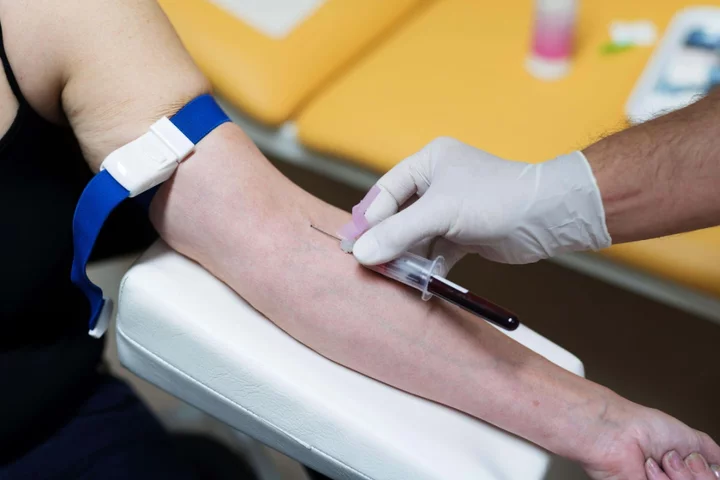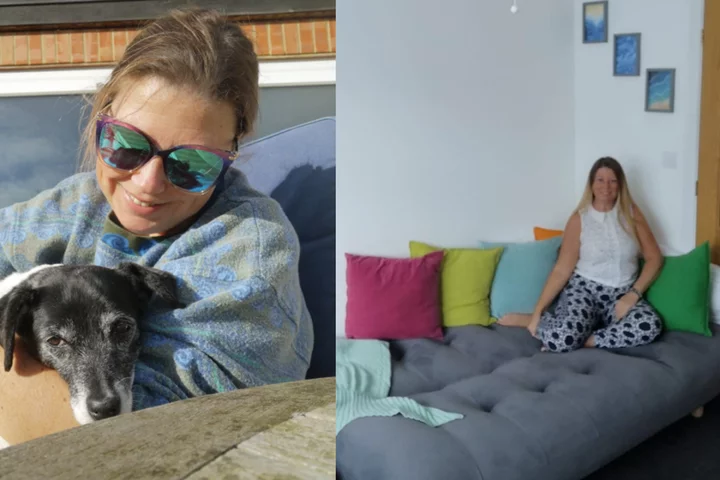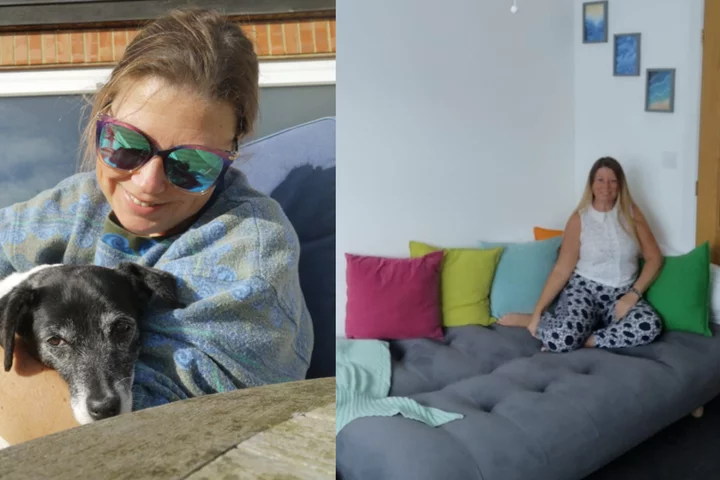
The two best exercises for lowering blood pressure, according to study
Exercises such as “wall sits” could be the best form of activity to help people reduce blood pressure, a new study suggests. Other physical activity including cardio, resistance training and HIIT workouts are also good for bringing down resting blood pressure levels, researchers found. But isometric exercises – those that involve engaging muscles without movement, such as wall sits and planks – provide the best results, they said. The study, published in the British Journal of Sports Medicine, saw researchers conduct analysis on previous studies looking at exercise and blood pressure. Some 270 studies were included in the final analysis which contained data on almost 16,000 people. They examined the impact different exercises had on systolic blood pressure, which notes the force at which the heart pumps blood around the body; and diastolic blood pressure, the resistance to the blood flow in the blood vessels between heartbeats when blood is pumped around the heart. The researchers, led by academics at Canterbury Christ Church University in Kent, found that there were significant reductions in resting blood pressure following cardio (aerobic exercise); dynamic resistance training, such as squats, press-ups and weights; high intensity interval training (HIIT); and combined training and HIIT. But the largest reductions were seen after isometric exercise training. A secondary analysis on specific types of exercises found the most benefit was seen among those who performed “isometric wall squats” and among runners. The academics said that current exercise recommendations for the prevention and treatment of high blood pressure are based on “older data” and suggest that it may be time to review the current guidelines. “Aerobic exercise training, dynamic resistance training, combined training, high-intensity interval training and isometric exercise training are all significantly effective in reducing resting systolic and diastolic blood pressure,” they wrote. “Overall, isometric exercise training is the most effective mode in reducing both systolic and diastolic blood pressure. “These findings provide a comprehensive data driven framework to support the development of new exercise guideline recommendations for the prevention and treatment of arterial hypertension.” For the average adult high blood pressure is considered to be from 140/90mmHg. When a person’s blood pressure is too high it puts extra strain on blood vessels, heart and other organs, such as the brain, kidneys and eyes. Persistent high blood pressure can lead to a number of serious health problems including heart attacks, strokes and vascular dementia. While there are medications which can help, people can make a number of life-style changes to help bring their blood pressure down including regular exercise, losing weight, cutting back on caffeine, alcohol and salt. Read More Dating app screenshot culture is out of control Husband fired from family business after wife roleplayed with reborn dolls The bowel cancer symptom George Alagiah wished he’d caught earlier Charity boss speaks out over ‘traumatic’ encounter with royal aide Ukraine war’s heaviest fight rages in east - follow live
2023-07-28 19:51

Hepatitis B and C could cause ‘significantly higher cancer risk’ than smoking daily pack of cigarettes
People living with hepatitis B (HBV) and hepatitis C (HCV) could be just as likely or more likely to develop cancer than someone smoking a pack of cigarettes a day, new research suggests. According to the Center for Disease Analysis (CDA) Foundation, people infected with hepatitis B and C viruses “have a similar or significantly higher risk of developing cancer than someone who actively smokes one pack of cigarettes per day”, and therefore HBC and HBC should be “considered as cancer causing infections and international guidelines should be reconsidered accordingly”. Hepatitis is the term used to describe inflammation of the liver, according to the NHS. Hepatitis B is spread in the blood of an infected person – it can be spread from infected women to their babies, or through unprotected sex and injecting drugs – and hepatitis C is usually spread through blood-to-blood contact with an infected person. The NHS says HCV is most commonly spread in the UK through sharing needles used to inject drugs. The foundation found that HBV and HCV viruses are highly oncogenic. Oncogenes are mutated genes which can lead to cancers in multiple organs and sites. Homie Razavi, managing director at CDA Foundation said: “Hepatitis B and C infections are silent epidemics. These viral infections are cancer causing but since infected individuals don’t show any symptoms until it is too late, most infections go unnoticed. “It is important for all of us to recognise the high risk of cancer associated with hepatitis B and C infections and get patients linked to care. Treatment can reduce the risk of cancer by 85% or more.” As part of a call on World Hepatitis Day 2023 (July 28), the World Hepatitis Alliance (WHA) has launched a campaign called ‘We’re not waiting’ with its global network of 323 members in over 100 countries, in order speed up the fight against the disease, which claims a life every 30 seconds. In a new survey, the WHA found that 42% of people around the world are unaware that viral hepatitis is one of the leading causes of liver cancer. Nearly three-quarters (74%) of those surveyed said knowing that hepatitis causes liver cancer means they are more likely to get tested, whilst 82% would get vaccinated. In total, over 350 million people have been diagnosed with either hepatitis B or C around the world, which results in more than 1.1 million deaths every year. And by 2040, deaths caused by this disease could surpass mortality from malaria, HIV, and tuberculosis combined, according to the WHA. “Every year, more than a million lives are lost to hepatitis,” said Danjuma Adda, president of the WHA. “The theme of World Hepatitis Day 2023 is ‘We’re not waiting’. It’s a call to accelerate elimination efforts of viral hepatitis now and the urgent need for testing and treatment for the real people who need it. “Individuals and communities around the world are making change happen in their own lives and in [the] world around them. We celebrate them, while demanding more action. We’re not waiting for change – we’re fighting to make it happen.” Read More Charity boss speaks out over ‘traumatic’ encounter with royal aide Ukraine war’s heaviest fight rages in east - follow live
2023-07-28 17:57

Experts reveal the most unhygienic things in your kitchen – and how to get them clean
It’s likely there are countless things in your kitchen which look clean, but actually, they’re filthy. Could your dishcloths be making you sick? When was the last time you washed your tea towels? And do we really need to bleach the sink more than once a month? We asked an expert to find out. Knobs, door handles, and buttons The buttons and dials on your kitchen appliances could be a germ-fest. “People often neglect to clean these areas of the kitchen,” says Danielle Mason, a cleaning content creator – or ‘cleanfluencer’ – who creates tutorials and videos on TikTok and Instagram. “Most of the time, they don’t think it is important, but as you’re commonly handling raw meat and food, it’s extremely important to keep these areas clean, due to cross-contamination. “Always sanitise with a cloth – I like to do this with Zoflora, as it leaves a great smell afterwards, and kills bacteria from dirty fingers.” Cloths If what you clean with isn’t clean, chances are, your kitchen isn’t either. “I always leave my cloth to soak in bleach before going to bed every night,” says Mason. “This enables a new start in the morning with no bacteria. Also, make sure you’re replacing the cloths – I would suggest a new one every two weeks, whilst still bleaching every night. And make sure you’re not using this cloth on anything other than the kitchen, as you do not want to cross-contaminate.” Sponges Mason stresses sponges are unhygienic, as they’re constantly damp and can carry E. coli. “People tend not to use sponges, as they carry so many more germs, and even putting them in the microwave will not kill all of them. Avoid a sponge where possible.” Dish towels Dish towels and tea towels may not be changed anywhere near often enough. “You should have one for every day of the week, as they carry so many bacteria and germs, which get spread across the kitchen. If you’re drying pots and pans, and then wiping down your surfaces, it’s not good,” she says. Chopping boards Chopping boards – particularly wooden ones – could be a haven for bacteria. “You should have a different colour for different types of food, one for meat, fruit, and other foods,” advises Mason. “The best way to clean them is in a dishwasher, as it’s good to get rid of all the germs due to the very high heat. If you don’t like the dishwasher, then boil the kettle water and leave the chopping boards to soak in it. I use a steam cleaner on mine, as it kills 99.9% bacteria and there are no chemicals.” It is best to avoid wooden chopping boards altogether, as these cleaning methods may damage them. Kitchen sink “This is a massive breeder of bacteria and grime; a distinct microbiome is found in sinks. “The plumbing area found beneath sinks revealed microbial communities dominated by a group of bacteria called Proteobacteria. This phylum includes pathogens such as Salmonella and E. coli, which can cause serious disease,” Mason shares. “I’ve always been taught never to wash my hands in the sink, and to never throw dirty water down the sink. You wash your cups and plates in the sink and prepare food, so it should always be kept clean, and nothing from outside the kitchen should cross-contaminate that. For example, never wash your floors and put dirty water in your kitchen sink, always throw it down the toilet.” How do you possibly clean the inside of your sink and drains? “Baking soda and vinegar is the best way to clean your sink out, or bleach, but you must be careful with bleach, as it can stay in the bottom of your sink, depending on the material it’s made of. I clean my sink out every day.” Pipes and cupboards around your sink could be leading you to have a rodent problem. “You can prevent mice and rodents from entering the kitchen by covering any small crevices or cracks. It is also important to repair leaks as soon as they happen, as they can come through the pipes,” she says. Fridges “Deep clean [your fridge] every two months. A normal cleaning – the wiping of shelves – should be done every other day with soapy water. For any bad smells, use baking soda, which will absorb the smell from the fridge,” Mason continues. “The fridge is a breeding ground for salmonella, E. Coli and other bacteria.” Bins Where you throw your waste away could be a breeding ground for germs. “Make sure you keep [outdoor] rubbish bins away from your house, and make sure you empty your bin as soon as it’s full,” advises Mason. “I personally do not keep a bin in the kitchen, I use a bag and I take that out by the end of the day, but if you are using a bin, make sure you bleach it with hot kettle water, to keep it smelling fresh.” Read More This is why you keep waking up at 4am – and what you can do about it TV chef James Martin reveals cancer diagnosis in apology over ‘bullying’ allegations Bursts of activity that make you huff and puff ‘linked to reduced cancer risk’ Charity boss speaks out over ‘traumatic’ encounter with royal aide Ukraine war’s heaviest fight rages in east - follow live
2023-07-28 17:48

Senate passes defense policy bill, setting up showdown with the House
The Senate passed a critical national defense policy bill Thursday evening -- setting up a showdown with the Republican-controlled House.
2023-07-28 08:20

Hunter Biden's plea deal collapsed. What happens now?
Lawyers have 30 days to reach a deal that avoids trial after a judge rejected another plea agreement.
2023-07-28 04:59

Wildfires in Portugal: Is it safe to travel to Lisbon and Cascais right now?
As wildfires rage across Sicily and Greece, Portugal is the latest Mediterranean country to be hit. A fire broke out on 26 July near the popular coastal holiday spot of Cascais, just 30km west of capital city Lisbon. The blaze started at 5pm in part of the Sintra-Cascais natural park, with strong winds fanning the flames and quickening the spread. Local residents chipped in to help the hundreds of Portuguese firefighters sent to tackle the fires, with some attempting to protect their homes and villages with buckets of water and hosepipes. “The fear now is that it will get to the houses,” local resident Ines Figueiredo told Reuters. “We try to help as much as we can with buckets (of water) ... but it’s not worth much.” Planes were also dispatched to waterbomb the blaze before night fell, alongside more than 600 firefighters. Winds of of up to 60km/h were the biggest obstacle to putting out the fire, according to the mayor of Cascais, Carlos Carreiras. A number of local residents have been evacuated as a precaution. If you’re booked to travel to Portugal, is it still safe to go? And what are your rights if you cancel a holiday? Here’s what we know. Where is affected by the wildfires? So far, the fire is contained to Sintra-Cascais natural park; it hasn’t spread as far as the resort of Cascais, popular with holidaymakers for its beaches and vibrant marina. Some villages within the vicinity of the park have been affected, with nine firefighters and four civilians so far treated for minor injuries and some residents evacuated. Elsewhere, smaller blazes have been reported in the north and centre of Portugal, one of which is near the second city of Porto. The highest level of alert for rural fire danger has been issued for several regions, including holidaymakers’ favourite, Faro in the Algarve. Is it safe to travel to Portugal? So far, the one major blaze has yet to impact on any areas that tourists are likely to visit. Unlike the Greek island of Rhodes, where a number of holidaymakers have had to be evacuated from the worst-affected areas, Portugal’s wildfires won’t affect the overwhelming majority of visitors. The UK Foreign Office (FCDO) advice on Portugal has not been updated to reflect the latest fires; its standard advice reads: “Forest fires can occur anywhere in Portugal. Risk of fires is higher when the weather is hot and dry. Fires have become more common due to drought and high temperatures. “Forest fires are highly dangerous and unpredictable. The Portuguese authorities may evacuate areas and close roads for safety reasons. You should: familiarise yourself with local safety and emergency procedures follow the advice of the Portuguese authorities call the emergency services on 112 if you see a wildfire “Starting a forest fire, even if it is by accident, is illegal in Portugal.” No holidays to Portugal appear to have been cancelled by travel companies at this time. Can I cancel my holiday to Portugal? Cancelling a holiday to Portugal based on the currently very small risk of fire impacting the trip would very likely lead to you losing any money paid so far. While most tour operators are offering customers due to travel to fire-affected parts of Rhodes the option of cancelling and rebooking, the same is not true of Portugal, where the blaze is yet to affect tourist areas. If you’ve booked travel and accommodation separately, rebooking flights in many cases costs as much as buying a whole new ticket. Cancellation costs incurred also won’t be covered by your travel insurance in the vast majority of cases, as the FCDO has not issued an advisory against all “non-essential” travel to Portugal. Read More More than two million expected to head overseas for summer getaway despite heatwave 8 best cities and towns in Portugal to visit on your next holiday Best beaches and seaside holidays in Europe 2023 ‘I cannot hold the pee’: Woman caught urinating on plane cabin floor How to spot a hidden camera in your Airbnb Tourists flying into Greece inferno reveal why they refuse to cancel holiday
2023-07-27 17:53

The most unhygienic things in your kitchen revealed – and how to get them clean
It’s likely there are countless things in your kitchen which look clean, but actually, they’re filthy. Could your dishcloths be making you sick? When was the last time you washed your tea towels? And do we really need to bleach the sink more than once a month? We asked an expert to find out. Knobs, door handles, and buttons The buttons and dials on your kitchen appliances could be a germ-fest. “People often neglect to clean these areas of the kitchen,” says Danielle Mason, a cleaning content creator – or ‘cleanfluencer’ – who creates tutorials and videos on TikTok and Instagram. “Most of the time, they don’t think it is important, but as you’re commonly handling raw meat and food, it’s extremely important to keep these areas clean, due to cross-contamination. “Always sanitise with a cloth – I like to do this with Zoflora, as it leaves a great smell afterwards, and kills bacteria from dirty fingers.” Cloths If what you clean with isn’t clean, chances are, your kitchen isn’t either. “I always leave my cloth to soak in bleach before going to bed every night,” says Mason. “This enables a new start in the morning with no bacteria. Also, make sure you’re replacing the cloths – I would suggest a new one every two weeks, whilst still bleaching every night. And make sure you’re not using this cloth on anything other than the kitchen, as you do not want to cross-contaminate.” Sponges Mason stresses sponges are unhygienic, as they’re constantly damp and can carry E. coli. “People tend not to use sponges, as they carry so many more germs, and even putting them in the microwave will not kill all of them. Avoid a sponge where possible.” Dish towels Dish towels and tea towels may not be changed anywhere near often enough. “You should have one for every day of the week, as they carry so many bacteria and germs, which get spread across the kitchen. If you’re drying pots and pans, and then wiping down your surfaces, it’s not good,” she says. Chopping boards Chopping boards – particularly wooden ones – could be a haven for bacteria. “You should have a different colour for different types of food, one for meat, fruit, and other foods,” advises Mason. “The best way to clean them is in a dishwasher, as it’s good to get rid of all the germs due to the very high heat. If you don’t like the dishwasher, then boil the kettle water and leave the chopping boards to soak in it. I use a steam cleaner on mine, as it kills 99.9% bacteria and there are no chemicals.” It is best to avoid wooden chopping boards altogether, as these cleaning methods may damage them. Kitchen sink “This is a massive breeder of bacteria and grime; a distinct microbiome is found in sinks. “The plumbing area found beneath sinks revealed microbial communities dominated by a group of bacteria called Proteobacteria. This phylum includes pathogens such as Salmonella and E. coli, which can cause serious disease,” Mason shares. “I’ve always been taught never to wash my hands in the sink, and to never throw dirty water down the sink. You wash your cups and plates in the sink and prepare food, so it should always be kept clean, and nothing from outside the kitchen should cross-contaminate that. For example, never wash your floors and put dirty water in your kitchen sink, always throw it down the toilet.” How do you possibly clean the inside of your sink and drains? “Baking soda and vinegar is the best way to clean your sink out, or bleach, but you must be careful with bleach, as it can stay in the bottom of your sink, depending on the material it’s made of. I clean my sink out every day.” Pipes and cupboards around your sink could be leading you to have a rodent problem. “You can prevent mice and rodents from entering the kitchen by covering any small crevices or cracks. It is also important to repair leaks as soon as they happen, as they can come through the pipes,” she says. Fridges “Deep clean [your fridge] every two months. A normal cleaning – the wiping of shelves – should be done every other day with soapy water. For any bad smells, use baking soda, which will absorb the smell from the fridge,” Mason continues. “The fridge is a breeding ground for salmonella, E. Coli and other bacteria.” Bins Where you throw your waste away could be a breeding ground for germs. “Make sure you keep [outdoor] rubbish bins away from your house, and make sure you empty your bin as soon as it’s full,” advises Mason. “I personally do not keep a bin in the kitchen, I use a bag and I take that out by the end of the day, but if you are using a bin, make sure you bleach it with hot kettle water, to keep it smelling fresh.” Read More Charity boss speaks out over ‘traumatic’ encounter with royal aide Ukraine war’s heaviest fight rages in east - follow live Laura Whitmore: I feel unsafe as a woman Meet the professional cuddler charging £70-an-hour to hug ‘the big spoons in life’ New warnings about ‘concerning’ rise in at-home cosmetic dentistry
2023-07-27 14:29

Sarah Jessica Parker says she and Matthew Broderick cook ‘every night’ with their three children
Sarah Jessica Parker has shared a rare glimpse inside her family life with husband Matthew Broderick. In a recent appearance on the Table for Two with Bruce Bozzi podcast, the Sex and the City alum revealed the daily routine that she and her husband share with their three children: son James, 20, and 14-year-old twin daughters Tabitha and Marion. “We cook every night,” she told host Bozzi during Tuesday’s episode. “It’s a source of a huge amount of pride for everybody.” The And Just Like That star even admitted that the family rarely orders takeout, adding how surprised she is to hear when other families order to-go. “It’s also mystifying because we just don’t order in as a family,” Parker said. “And on the rare occasion we have - we always hear other families, they do it, and then like one kid orders from this place and one kid…it’s so confusing.” While Parker’s iconic Sex and the City character Carrie Bradshaw is notorious for her lack of culinary skills, the 58-year-old actor assured that her family “really [does] cook five to six nights a week”. “We have always have a Sunday dinner - we invite people,” she added. Throughout the years, Sarah Jessica Parker and Matthew Broderick have kept much of their family life out of the spotlight. Although the longtime couple have been married since 1997, the Hocus Pocus star recently revealed that they haven’t “spent a night apart” from each other in more than three decades. While speaking on Sirius XM’s The Howard Stern Show earlier this month, Parker recalled that her first date with the Ferris Bueller’s Day Off actor took place on 8 March 1992, and that she and her partner have “been together” ever since. “We’ve never spent a night apart since then, with the exception of work on location,” she told host Stern. “Or, his mother was ill for a bit so he went to take care of her. But from that first night, we’ve never been apart.” Parker said that “pretty soon into” their relationship, she felt like she was “in love” with Broderick and thought he was “really incredible”. The actor explained how she “admired” her soon-to-be husband before they started dating, noting that she had “loved” his work. “He’s so smart, he’s so funny, I like this choice of friends, the way he was living in New York, what was important to him, how he kind of travelled around the city,” she said. “He was always travelling around on his bicycle, he’s been riding bikes since he was 14.” The two also shared a common interest in raising a family in New York. “I love being home in New York,” Parker said. “I wanted to build a life here and he was born and raised in the West Village, literally, he’s never lived north of 11th Street.” Last month, Sarah Jessica Parker and Matthew Broderick celebrated their 26th wedding anniversary. “Happy 26th anniversary my husband,” she wrote on Instagram, alongside a photo of a champagne cork. “That sure was a nice celebration and a real nice bottle of champagne. And a gorgeous walk home. Oh the miles we have strolled together. I love you. XOX, your SJ.” Read More Sarah Jessica Parker reveals she and husband Matthew Broderick haven’t ‘spent a night apart’ in 31 years Sarah Jessica Parker says she ‘missed out’ on ‘old-fashioned facelift’ as she reflects on ageism Sarah Jessica Parker rewears iconic Vivienne Westwood wedding dress in And Just Like That Sarah Jessica Parker shares rare glimpse into her family life What is cardiac arrest? The condition that LeBron James’ son suffered from Mother asks if children should be ‘forced to share’ after park incident
2023-07-27 04:25

Sarah Jessica Parker shares rare glimpse inside her family life: ‘We cook every night’
Sarah Jessica Parker has shared a rare glimpse inside her family life with husband Matthew Broderick. In a recent appearance on the Table for Two with Bruce Bozzi podcast, the Sex and the City alum revealed the daily routine that she and her husband share with their three children: son James, 20, and 14-year-old twin daughters Tabitha and Marion. “We cook every night,” she told host Bozzi during Tuesday’s episode. “It’s a source of a huge amount of pride for everybody.” The And Just Like That star even admitted that the family rarely orders takeout, adding how surprised she is to hear when other families order to-go. “It’s also mystifying because we just don’t order in as a family,” Parker said. “And on the rare occasion we have - we always hear other families, they do it, and then like one kid orders from this place and one kid…it’s so confusing.” While Parker’s iconic Sex and the City character Carrie Bradshaw is notorious for her lack of culinary skills, the 58-year-old actor assured that her family “really [does] cook five to six nights a week”. “We have always have a Sunday dinner - we invite people,” she added. Throughout the years, Sarah Jessica Parker and Matthew Broderick have kept much of their family life out of the spotlight. Although the longtime couple have been married since 1997, the Hocus Pocus star recently revealed that they haven’t “spent a night apart” from each other in more than three decades. While speaking on Sirius XM’s The Howard Stern Show earlier this month, Parker recalled that her first date with the Ferris Bueller’s Day Off actor took place on 8 March 1992, and that she and her partner have “been together” ever since. “We’ve never spent a night apart since then, with the exception of work on location,” she told host Stern. “Or, his mother was ill for a bit so he went to take care of her. But from that first night, we’ve never been apart.” Parker said that “pretty soon into” their relationship, she felt like she was “in love” with Broderick and thought he was “really incredible”. The actor explained how she “admired” her soon-to-be husband before they started dating, noting that she had “loved” his work. “He’s so smart, he’s so funny, I like this choice of friends, the way he was living in New York, what was important to him, how he kind of travelled around the city,” she said. “He was always travelling around on his bicycle, he’s been riding bikes since he was 14.” The two also shared a common interest in raising a family in New York. “I love being home in New York,” Parker said. “I wanted to build a life here and he was born and raised in the West Village, literally, he’s never lived north of 11th Street.” Last month, Sarah Jessica Parker and Matthew Broderick celebrated their 26th wedding anniversary. “Happy 26th anniversary my husband,” she wrote on Instagram, alongside a photo of a champagne cork. “That sure was a nice celebration and a real nice bottle of champagne. And a gorgeous walk home. Oh the miles we have strolled together. I love you. XOX, your SJ.” Read More Sarah Jessica Parker reveals she and husband Matthew Broderick haven’t ‘spent a night apart’ in 31 years Sarah Jessica Parker says she ‘missed out’ on ‘old-fashioned facelift’ as she reflects on ageism Sarah Jessica Parker rewears iconic Vivienne Westwood wedding dress in And Just Like That What is cardiac arrest? The condition that LeBron James’ son suffered from Mother asks if children should be ‘forced to share’ after park incident Scientists share habits that could take 20 years off your life
2023-07-27 04:22

Meet the former therapist making a living as a professional cuddler
A professional cuddler who makes a living giving clients hugs has said people travel from all over the globe to receive the cuddle therapy she offers which is “far less intimate than a massage” and helps people from “all walks of life”. Natasha Wicks, 44, from Coventry, West Midlands, says that despite criticism, cuddling is scientifically proven to release happy hormones like dopamine and that a lot of her clients are “the big spoon in life” and go to her for emotional support that they do not have at home. As such, many of her clients are caregivers and most of them join Natasha for two-hour hugging sessions, costing £70 an hour. The sessions vary depending on what the client wants, some having “emotional hugs”, others talking more and some wanting to “sit at opposite ends of the sofa with our legs and feet entwined”. Natasha became a cuddle therapist in 2015 and, while she has had comments online from people criticising the practice, she said that her family and friends were unsurprised when she first started giving professional cuddles. She said: “They all said to me that I give the best cuddles so it’s not surprising that I’d start doing it as a job. “It’s very much what I do, I help people and want to make people feel better. It’s a natural thing when someone is going through a tough time to want to give them a hug. “Cuddle therapy might not be as widely accepted in society but it’s far less intimate than other things like massages which are seen as normal.” Prior to becoming a cuddler, Natasha originally trained as a CBT therapist and counsellor. She said: “There’d be situations where I would be talking to someone and they’d really need a hug, but obviously, you’d have professional boundaries in place and it wouldn’t have been appropriate. “It was just a really natural thing. One client had finished her final session and we had agreed that she wasn’t my patient anymore so we hugged goodbye. She said to me that she’d wanted to do that for a long time and I thought ‘me too’.” Looking into cuddle therapy, which she said was increasing in popularity in 2014, Natasha took a training course. By 2015, she was a qualified cuddler and started taking on new patients for cuddle sessions. Natasha provides a minimum session of one hour but said most people go for at least two hours, sometimes longer if they are receiving more than one type of therapy. She said: “I always give people a hug on the doorstep when they arrive and then they’ll come in and relax, and we’ll have an initial chat about what brings them here. After that, I’ll put on some ambient music and we’ll have a cuddle on my cuddle sofa. “It can be daunting coming into a stranger’s house and I can tell the difference in them from arriving to leaving. The first hug they might be angled away from me but when we’re hugging goodbye, I can get my head in between their neck and shoulders and you can almost feel that a weight has been lifted from them.” There is not one type of person that visits Natasha for cuddles, but she says that a lot of her clients are caregivers. She said: “There’s all sorts of people who come for a cuddle, from people who have moved away from home for the first time and just want a mum hug all the way to people in their 80s. “I’m inclusive of all genders and all ages. I get a lot of clients who are the carers of their family and they are so busy looking after other people, and probably giving the hugs and support to other people, that they don’t have that for themselves. “A lot of people that come to see me are generally people are the big spoon in the life – they take care of others and don’t want to show a vulnerable side to people because they don’t want people to worry that they can’t cope. “I get a lot of carers, a lot of NHS staff, a lot of mums, a lot of people that are in a world where they have to be the strong one in the situation and they just want to be able to come here and let their guard down.” Natasha’s priority is to make people feel at ease when they arrive as she said it can be “nerve wracking” turning up at someone’s house for a hug. Setting out clear boundaries prior to meeting, the therapist has said that the patients she has welcomed into her home have all been respectful. She added: “I always say to people that when your body relaxes, your tummy might crumble and mine might too, but that people don’t need to worry about it. Sometimes people fall asleep and they might snore or fart, it’s just natural things that happen. It’s happened twice where someone has got an erection and that’s fine, I have boundaries and we’ll just change position. “I want people to feel reassured that, as soon as they get in, they feel comfortable.” Despite the unconventional therapy, when Natasha first took on cuddle clients, she said her family were completely “unsurprised” and the step from CBT therapy to cuddle therapy was a “natural evolution”. While Natasha focuses her time on a holistic approach for treating people, she noted that there is also neuroscience behind cuddles. According to the 44-year-old, physical touch activates the brain’s orbitofrontal cortex and cuddling releases oxytocin, dopamine and serotonin. Now, Natasha also does EMDR therapy and is a mental health swim host, and has clients travel from all over the globe to receive her hugs. She said: “Working from Coventry is brilliant because I’m only nine minutes on the train from Birmingham Airport and people come to visit me from all over. I get a client from Belgium, someone from Ireland and people from all over the UK who come to see me. “I wanted to find a sofa bed that just looked like a big comfy sofa for cuddle sessions. I’d started off with a big L shaped sofa but after about five years, it was sagging a bit, there’d been a lot of healing done on that sofa and it was time for a new one. “Now I have a sofa bed in my living room that I use as my cuddle sofa. It’s in the living room and it’s used for everyday life, watching TV with my partner, having people round and also for my work.” Breaking down the taboo around cuddle therapy, Natasha hopes more people will embrace the alternative treatment. She added: “As it’s become more popular, more people are becoming qualified as cuddlers and I think that’s great. “I’ve had comments online before of people thinking it’s weird or not understanding but there are other things we accept in society that are much more intimate than cuddles, like massages. “It’s not weird, it’s actually a really lovely thing to be able to make another soul feel better for a while.” Read More Charity boss speaks out over ‘traumatic’ encounter with royal aide Ukraine war’s heaviest fight rages in east - follow live Meet the professional cuddler charging £70-an-hour to hug ‘the big spoons in life’ New warnings about ‘concerning’ rise in at-home cosmetic dentistry What is ‘beer tanning’ and why are experts warning against it?
2023-07-26 22:45

Meet the professional cuddler charging £70-an-hour to hug ‘the big spoons in life’
A professional cuddler who makes a living giving clients hugs has said people travel from all over the globe to receive the cuddle therapy she offers which is “far less intimate than a massage” and helps people from “all walks of life”. Natasha Wicks, 44, from Coventry, West Midlands, says that despite criticism, cuddling is scientifically proven to release happy hormones like dopamine and that a lot of her clients are “the big spoon in life” and go to her for emotional support that they do not have at home. As such, many of her clients are caregivers and most of them join Natasha for two-hour hugging sessions, costing £70 an hour. The sessions vary depending on what the client wants, some having “emotional hugs”, others talking more and some wanting to “sit at opposite ends of the sofa with our legs and feet entwined”. Natasha became a cuddle therapist in 2015 and, while she has had comments online from people criticising the practice, she said that her family and friends were unsurprised when she first started giving professional cuddles. She said: “They all said to me that I give the best cuddles so it’s not surprising that I’d start doing it as a job. “It’s very much what I do, I help people and want to make people feel better. It’s a natural thing when someone is going through a tough time to want to give them a hug. “Cuddle therapy might not be as widely accepted in society but it’s far less intimate than other things like massages which are seen as normal.” Prior to becoming a cuddler, Natasha originally trained as a CBT therapist and counsellor. She said: “There’d be situations where I would be talking to someone and they’d really need a hug, but obviously, you’d have professional boundaries in place and it wouldn’t have been appropriate. “It was just a really natural thing. One client had finished her final session and we had agreed that she wasn’t my patient anymore so we hugged goodbye. She said to me that she’d wanted to do that for a long time and I thought ‘me too’.” Looking into cuddle therapy, which she said was increasing in popularity in 2014, Natasha took a training course. By 2015, she was a qualified cuddler and started taking on new patients for cuddle sessions. Natasha provides a minimum session of one hour but said most people go for at least two hours, sometimes longer if they are receiving more than one type of therapy. She said: “I always give people a hug on the doorstep when they arrive and then they’ll come in and relax, and we’ll have an initial chat about what brings them here. After that, I’ll put on some ambient music and we’ll have a cuddle on my cuddle sofa. “It can be daunting coming into a stranger’s house and I can tell the difference in them from arriving to leaving. The first hug they might be angled away from me but when we’re hugging goodbye, I can get my head in between their neck and shoulders and you can almost feel that a weight has been lifted from them.” There is not one type of person that visits Natasha for cuddles, but she says that a lot of her clients are caregivers. She said: “There’s all sorts of people who come for a cuddle, from people who have moved away from home for the first time and just want a mum hug all the way to people in their 80s. “I’m inclusive of all genders and all ages. I get a lot of clients who are the carers of their family and they are so busy looking after other people, and probably giving the hugs and support to other people, that they don’t have that for themselves. “A lot of people that come to see me are generally people are the big spoon in the life – they take care of others and don’t want to show a vulnerable side to people because they don’t want people to worry that they can’t cope. “I get a lot of carers, a lot of NHS staff, a lot of mums, a lot of people that are in a world where they have to be the strong one in the situation and they just want to be able to come here and let their guard down.” Natasha’s priority is to make people feel at ease when they arrive as she said it can be “nerve wracking” turning up at someone’s house for a hug. Setting out clear boundaries prior to meeting, the therapist has said that the patients she has welcomed into her home have all been respectful. She added: “I always say to people that when your body relaxes, your tummy might crumble and mine might too, but that people don’t need to worry about it. Sometimes people fall asleep and they might snore or fart, it’s just natural things that happen. It’s happened twice where someone has got an erection and that’s fine, I have boundaries and we’ll just change position. “I want people to feel reassured that, as soon as they get in, they feel comfortable.” Despite the unconventional therapy, when Natasha first took on cuddle clients, she said her family were completely “unsurprised” and the step from CBT therapy to cuddle therapy was a “natural evolution”. While Natasha focuses her time on a holistic approach for treating people, she noted that there is also neuroscience behind cuddles. According to the 44-year-old, physical touch activates the brain’s orbitofrontal cortex and cuddling releases oxytocin, dopamine and serotonin. Now, Natasha also does EMDR therapy and is a mental health swim host, and has clients travel from all over the globe to receive her hugs. She said: “Working from Coventry is brilliant because I’m only nine minutes on the train from Birmingham Airport and people come to visit me from all over. I get a client from Belgium, someone from Ireland and people from all over the UK who come to see me. “I wanted to find a sofa bed that just looked like a big comfy sofa for cuddle sessions. I’d started off with a big L shaped sofa but after about five years, it was sagging a bit, there’d been a lot of healing done on that sofa and it was time for a new one. “Now I have a sofa bed in my living room that I use as my cuddle sofa. It’s in the living room and it’s used for everyday life, watching TV with my partner, having people round and also for my work.” Breaking down the taboo around cuddle therapy, Natasha hopes more people will embrace the alternative treatment. She added: “As it’s become more popular, more people are becoming qualified as cuddlers and I think that’s great. “I’ve had comments online before of people thinking it’s weird or not understanding but there are other things we accept in society that are much more intimate than cuddles, like massages. “It’s not weird, it’s actually a really lovely thing to be able to make another soul feel better for a while.” Read More Charity boss speaks out over ‘traumatic’ encounter with royal aide Ukraine war’s heaviest fight rages in east - follow live New warnings about ‘concerning’ rise in at-home cosmetic dentistry What is ‘beer tanning’ and why are experts warning against it? Christian Cowan: Designing is like dreaming
2023-07-26 22:45

Hyundai Motor's Q2 net profit jumps 15%, slightly misses expectations
SEOUL (Reuters) -South Korea's Hyundai Motor Co reported on Wednesday a 15% rise in second-quarter profit helped by solid sales
2023-07-26 13:26
